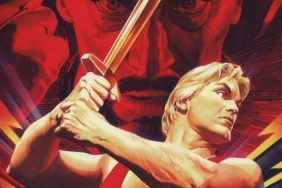Titan Books continues to do a great service for the comic book lovers worldwide. On a regular basis, they collect and release classic comics from the Golden, Silver and Bronze age. This month, Titan is gracing us with Science Fiction, a massive gathering of Golden Age sci-fi comics from icons Joe Simon and Jack Kirby. Though their success hit its pinnacle with they creation of Captain America, Simon & Kirby were responsible for some of the greatest comic creations of all time. Superheroes, crime comics, teen adventures – you name it, these two men knocked it out of the park.

Science Fiction is a gorgeous hardcover book featuring gloriously restored colors and inks by Harry Mendryk, plus an intro from Watchmen artist Dave Gibbons. At three hundred plus pages, this is a must have not only for Simon & Kirby fans, but anybody who is a true student of the medium. The book is split into two sections, the 1930s and 40s, though you can really open to any page and find an awesome adventure. I opened to a random page and found myself confronted with alien dogs with huge heads dressed in military uniforms. It just doesn’t get better than that.
If you do read Science Fiction straight through, the 30’s opens with “Solar Patrol,” a rare comic written and penciled by Simon. From there, we get a collaboration titled “Solar Legion” and then a string of Blue Bolt adventures. Don’t worry, for those who love the Blue Bolt, Science Fiction covers the sapphire space hero for over one hundred pages. The first space thrill ride for the 1940s is “The Emissary,” a touching story of our human reactions to things that are different and our universal fear of the unknown. I always enjoyed that about Joe Simon – he could write things that were either incredibly deep or incredibly simple and both would be equally entertaining.
Simon was a master at creating full story arcs in limited spaces. Take the story “Strange Vision.” Within four pages, Simon introduces us to an unlikable character, gives this character a second chance, and then shows us the life lesson he’s learned. I know writers who can’t accomplish this in a 22-page book. Simon does it time after time in a fifth of that space. Some will argue that the simpler age allowed for easier stories. To them, I’d argue that Joe Simon’s work continues to hold up, even eighty plus years later. You can’t top great storytelling, and Joe Simon is one of the greatest ever.
Then we have Jack Kirby’s art. What do I say? What can I say that doesn’t sound stupid or redundant? His work is inspiring, brilliant, the disturbed craft of a mad genius? It’s all true. Kirby is the spine by which the entire body of comic books is built. Alongside Will Eisner, Kirby redefined sequential storytelling through pictures and made a legitimate art form out of something universally reviled in the early part of the last century. Kirby’s imagination is unparalleled, as are his penciling techniques. At times, his understanding of anatomy is off, but it doesn’t matter, the art still works across the board. View the child with the abnormal head in “Black Cat Mystic.” With a few lines and some heavy inks, Kirby hands us one of the most disturbing comic strips ever. There has never been, nor will there ever be, anybody who is the equal of Jack Kirby.
Outside of being entertaining, collections like Science Fiction are invaluable for their ability to let us peek into a different world of comic books. Between computers and digital tricks, we’ve all become used to the slick and mass-produced look of modern comics. These types of books allow us to remember, and stand in awe, of a time when each panel was painfully hand drawn, lettered and inked. There’s a humanity to these strips that modern comics lack, which is why a book like Science Fiction is so important.




